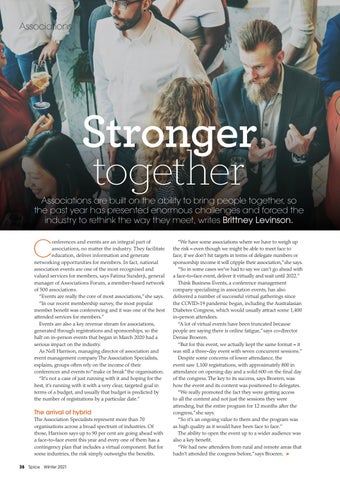Associations
Stronger together Associations are built on the ability to bring people together, so the past year has presented enormous challenges and forced the industry to rethink the way they meet, writes Brittney Levinson.
C
onferences and events are an integral part of associations, no matter the industry. They facilitate education, deliver information and generate networking opportunities for members. In fact, national association events are one of the most recognised and valued services for members, says Fatima Sunderji, general manager of Associations Forum, a member-based network of 500 associations. “Events are really the core of most associations,” she says. “In our recent membership survey, the most popular member benefit was conferencing and it was one of the best attended services for members.” Events are also a key revenue stream for associations, generated through registrations and sponsorships, so the halt on in-person events that began in March 2020 had a serious impact on the industry. As Nell Harrison, managing director of association and event management company The Association Specialists, explains, groups often rely on the income of their conferences and events to “make or break” the organisation. “It’s not a case of just running with it and hoping for the best, it’s running with it with a very clear, targeted goal in terms of a budget, and usually that budget is predicted by the number of registrations by a particular date.”
The arrival of hybrid The Association Specialists represent more than 70 organisations across a broad spectrum of industries. Of those, Harrison says up to 90 per cent are going ahead with a face-to-face event this year and every one of them has a contingency plan that includes a virtual component. But for some industries, the risk simply outweighs the benefits. 38 Spice Winter 2021
“We have some associations where we have to weigh up the risk – even though we might be able to meet face to face, if we don’t hit targets in terms of delegate numbers or sponsorship income it will cripple their association,”she says. “So in some cases we’ve had to say we can’t go ahead with a face-to-face event, deliver it virtually and wait until 2022.” Think Business Events, a conference management company specialising in association events, has also delivered a number of successful virtual gatherings since the COVID-19 pandemic began, including the Australasian Diabetes Congress, which would usually attract some 1,400 in-person attendees. “A lot of virtual events have been truncated because people are saying there is online fatigue,” says co-director Denise Broeren. “But for this event, we actually kept the same format – it was still a three-day event with seven concurrent sessions.” Despite some concerns of lower attendance, the event saw 1,100 registrations, with approximately 800 in attendance on opening day and a solid 600 on the final day of the congress. The key to its success, says Broeren, was how the event and its content was positioned to delegates. “We really promoted the fact they were getting access to all the content and not just the sessions they were attending, but the entire program for 12 months after the congress,” she says. “So it’s an ongoing value to them and the program was as high quality as it would have been face to face.” The ability to open the event up to a wider audience was also a key benefit. “We had new attendees from rural and remote areas that hadn’t attended the congress before,” says Broeren. ➤
